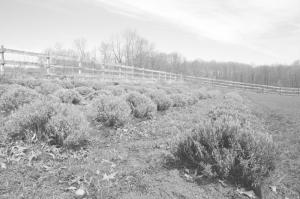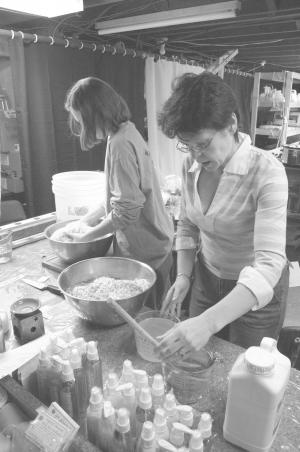Profitable Lavender Business Thrives On 14 Acres
Lavender is a high value, low maintenance perennial crop that offers a good return on investment, according to Jody Byrne of Streetsboro, Ohio. She knows from experience that this useful plant offers distinct advantages from a farming perspective.
"One acre of lavender will yield well for 8 to 10 years. An acre supports 34 rows of 80 plants," Byrne explains. "It takes three years from when 4-in. cuttings are planted until the first full harvest. Peak harvest is at about five years. Preliminary harvests may happen as soon as one year."
With a 14-acre plot in an expanding suburban area, she and husband Michael Slyker co-founded and operate DayBreak Lavender Farm. Byrne's daughter, granddaughter, and 11 seasonal employees complete the successful operation that has been called "a mixture of farming, marketing and artistry."
Byrne says average return on investment, for fresh or dried bundled lavender, is about $13,600 per acre ($5 per dried 2-in. bundle from each plant.) Peak harvest is 2 1/2 bundles per plant x 2,720 plants x $5 = $34,000 per acre.
"But the demand for our bath and body products is so great that we don't sell lavender bundles any more. We use it all!" she says. A "lab" in the basement of her home serves as her production center for a wide variety of lavender products.
"Demand outstrips supply for organic, farm-grown lavender and it's growing in direct proportion to the consumer's demand for all things natural."
Byrne calls lavender the "Swiss Army Knife of herbs" because it can be used and sold for crafts, cooking, perfumery, health and healing aids, bath and beauty products. When taken as a tea, lavender has been used to treat insomnia, depression, stress, headaches, and a variety of gastrointestinal ailments.
DayBreak produces garden-fresh spa and skin-care luxuries such as herbal soaps, botanical spa bars, all-natural crŞme lotions, bath teas, culinary herbal blends (lavender-infused culinary spices, sugars and honey) and homekeeping supplies such as beeswax and lavender furniture wax.
To do well, lavender requires a lot of sun, excellent drainage, and sweet, alkaline soil. Byrne amended a former cow pasture with organic, timed-release lime.
She cautions against planting seeds, as they are never true to variety, and instead, advises buying inexpensive starter plants in two-inch pots until you can make your own cuttings.
She planted her first lavender in 2000, and after first selling her products independently with great success, began wholesaling through retail stores in the spring of 2002. Demand for DayBreak's wide range of lavender products has been phenomenal.
A handful of stores in Ohio carry DayBreak products, but the family also sells at farmers' markets, directly from their farm at open houses, and via their website.
DayBreak's website is a storehouse of information and pictures, and one section is a treasure trove of detailed growing tips and instructions specifically for farmers who are considering getting into lavender.
Contact: FARM SHOW Followup, DayBreak Lavender Farm, Jody Byrne, 2129 Frost Rd., Streesboro, Ohio 44241 (ph 330 626-3235; fax 330 626-1749; email: Soapplease1@aol.com; website: www.soap-
please.com).

Click here to download page story appeared in.
Click here to read entire issue
Profitable Lavender Business Thrives On 14 Acres 29-1-9 Lavender is a high value, low maintenance perennial crop that offers a good return on investment, according to Jody Byrne of Streetsboro, Ohio. She knows from experience that this useful plant offers distinct advantages from a farming perspective.
"One acre of lavender will yield well for 8 to 10 years. An acre supports 34 rows of 80 plants," Byrne explains. "It takes three years from when 4-in. cuttings are planted until the first full harvest. Peak harvest is at about five years. Preliminary harvests may happen as soon as one year."
With a 14-acre plot in an expanding suburban area, she and husband Michael Slyker co-founded and operate DayBreak Lavender Farm. Byrne's daughter, granddaughter, and 11 seasonal employees complete the successful operation that has been called "a mixture of farming, marketing and artistry."
Byrne says average return on investment, for fresh or dried bundled lavender, is about $13,600 per acre ($5 per dried 2-in. bundle from each plant.) Peak harvest is 2 1/2 bundles per plant x 2,720 plants x $5 = $34,000 per acre.
"But the demand for our bath and body products is so great that we don't sell lavender bundles any more. We use it all!" she says. A "lab" in the basement of her home serves as her production center for a wide variety of lavender products.
"Demand outstrips supply for organic, farm-grown lavender and it's growing in direct proportion to the consumer's demand for all things natural."
Byrne calls lavender the "Swiss Army Knife of herbs" because it can be used and sold for crafts, cooking, perfumery, health and healing aids, bath and beauty products. When taken as a tea, lavender has been used to treat insomnia, depression, stress, headaches, and a variety of gastrointestinal ailments.
DayBreak produces garden-fresh spa and skin-care luxuries such as herbal soaps, botanical spa bars, all-natural crŞme lotions, bath teas, culinary herbal blends (lavender-infused culinary spices, sugars and honey) and homekeeping supplies such as beeswax and lavender furniture wax.
To do well, lavender requires a lot of sun, excellent drainage, and sweet, alkaline soil. Byrne amended a former cow pasture with organic, timed-release lime.
She cautions against planting seeds, as they are never true to variety, and instead, advises buying inexpensive starter plants in two-inch pots until you can make your own cuttings.
She planted her first lavender in 2000, and after first selling her products independently with great success, began wholesaling through retail stores in the spring of 2002. Demand for DayBreak's wide range of lavender products has been phenomenal.
A handful of stores in Ohio carry DayBreak products, but the family also sells at farmers' markets, directly from their farm at open houses, and via their website.
DayBreak's website is a storehouse of information and pictures, and one section is a treasure trove of detailed growing tips and instructions specifically for farmers who are considering getting into lavender.
Contact: FARM SHOW Followup, DayBreak Lavender Farm, Jody Byrne, 2129 Frost Rd., Streesboro, Ohio 44241 (ph 330 626-3235; fax 330 626-1749; email: Soapplease1@aol.com; website: www.soap-
please.com).
To read the rest of this story, download this issue below or click
here to register with your account number.









